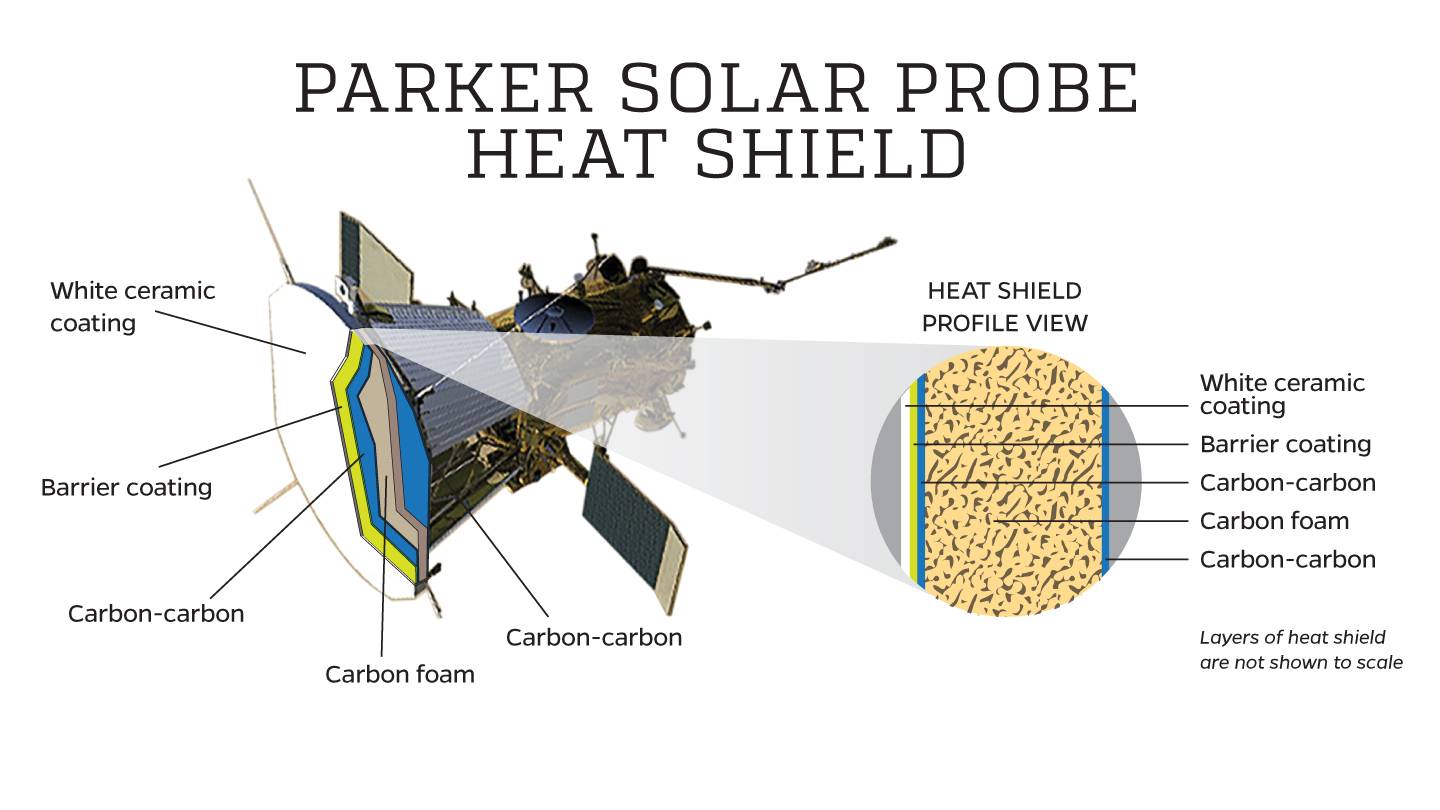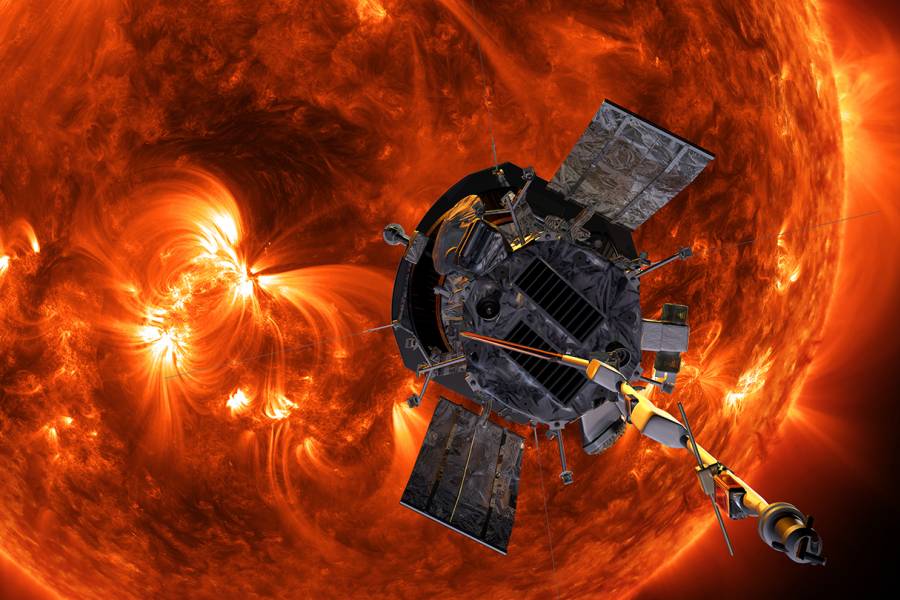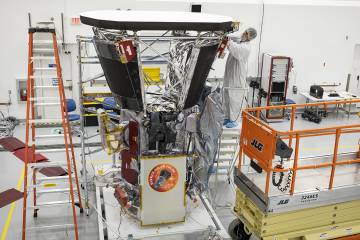- Name
- Geoff Brown
- Geoffrey.Brown@jhuapl.edu
- Office phone
- 240-228-5618
The star of the show is a dark gray block, about the size of a textbook, and several inches thick. As an audience of reporters watches, an engineer runs a flaming blowtorch over the block until its face heats to a red glow.
"You want to take a touch of the back surface?" she invites a NASA T-shirt-clad volunteer.
The volunteer reaches tentatively out to the back, first with one finger, and then with her whole hand.
"How does it feel?"
"Lukewarm," the volunteer responds. "Not even—normal."
Video credit: NASA Goddard
The demonstration, dubbed "Blowtorch vs. Heat Shield" on YouTube, represents the culmination of years of research, trial and error, and painstaking analysis by engineers at the Johns Hopkins University Applied Physics Laboratory to solve what they call the "thermal problem" of the Parker Solar Probe, a spacecraft that will travel within 4 million miles of the surface of the sun.
The "thermal problem" is a gentle way of referring to the complications of performing this record-breaking dive directly into our star's outer atmosphere, or corona. While the Parker Solar Probe orbits the star and records data with its onboard instruments, a thermal protection system, or TPS, will shield the spacecraft from the heat. Combined with a water-powered cooling system, the TPS will keep the majority of the spacecraft's instruments at about 85 degrees Fahrenheit—a nice summer day—while the TPS itself endures a temperature of 2500 degrees Fahrenheit.
Without the TPS, there's no probe.
"This was the technology that enabled us to do this mission—to enable it to fly," says Elisabeth Abel, TPS thermal lead. "It's going to be incredibly exciting to see something you put a lot of energy and hard work into, to see it actually fly. It's going to be a big day."
Video credit: Greg Stanley
The Parker Solar Probe is expected to launch from Kennedy Space Center in Cape Canaveral, Florida, this month—its launch window opens Saturday and runs through Aug. 23. During its seven-year mission, it'll explore some of the sun's greatest mysteries: Why is the solar wind a breeze closer to the sun but supersonic torrent farther away? Why is the corona itself millions of degrees hotter than the surface of the sun? What are the mechanisms behind the astoundingly fast-moving solar energetic particles that can interfere with spacecraft, disrupt communications on Earth, and endanger astronauts?
The launch will conclude 60 years of planning and effort, and more than a decade spent creating the heat shield that deflects the worst of the sun's energy.
The front and back faces of the heat shield are made of sheets of carbon-carbon, a lightweight material with superior mechanical properties especially suited for high temperatures. At less than a tenth of an inch thick, the two carbon-carbon sheets are thin enough to bend, even if they were laid on top of each other. Between them is about 4.5 inches of carbon foam, typically used in the medical industry for bone replacement. This sandwich design stiffens everything up—like corrugated cardboard—while allowing the 8-foot heat shield to weigh in at only about 160 pounds.
The foam also performs the heat shield's most essential structural functions. Carbon itself conducts heat, but carbon foam is 97 percent air. In addition to cutting the weight of the spacecraft to help it get into orbit, the foam structure means there's just not that much material for heat to travel through. The heat shield will be 2500 degrees Fahrenheit on the side facing the sun, but only 600 degrees Fahrenheit at the back.
The foam wasn't easy to test. It's extremely fragile, and there was another problem.
"When you get it hot, it can combust," Abel says.
Combustion isn't an issue in a vacuum (like in space), but leftover air in test chambers would cause the foam to char. So the engineers built their own vacuum chamber at Oak Ridge National Laboratory, where a high-temperature plasma-arc lamp facility could heat the material to the incredible temperatures the heat shield would endure.

Image credit: Greg Stanley / Office of Communications
But all of the carbon foam's impressive heat-dispersing properties weren't enough to keep the spacecraft at its required temperature. Because there's no air in space to provide cooling, the only way for material to expel heat is to scatter light and eject heat in the form of photons. For that, another layer of protection was necessary: a white coating that would reflect heat and light.
For that, APL turned to the Advanced Technology Laboratory in Johns Hopkins University's Whiting School of Engineering, where a fortunate coincidence had led to the assembly of a heat shield–coating dream team: experts in high-temperature ceramics, chemistry, and plasma spray coatings.
After extensive engineering and testing, the team settled on a coating based on bright white aluminum oxide. But that coating could react with the carbon of the heat shield in high temperatures and turn gray, so the engineers added a layer of tungsten, thinner than a strand of hair, between the heat shield and the coating to stop the two from interacting. They added nanoscale dopants to make the coating whiter and to inhibit the expansion of aluminum oxide grains when exposed to heat.
Then the engineers had to determine how best to create and apply the coating.
"The whole thing was struggling to find a ceramic coating that both reflects light and emits the heat," says Dennis Nagle, principal research engineer at the Center for Systems Science and Engineering.
Typically when working with enamel, Nagle says, a hard, nonporous coating is preferred—one that'll crack when hit with a hammer. But under the temperatures faced by the Parker Solar Probe, a smooth coating would shatter like a window hit with a rock. Instead the goal was a uniformly porous coating that would withstand extreme environments. When cracks start in a porous coating, they'll stop when they hit a pore. The coating was made of several rough, grainy layers—enough that one set of ceramic grains would reflect light that another layer misses.
"I always tell people it works because it's a lousy coating," jokes Nagle. "If you want to make a good coating, it'll fail."
After the Parker Solar Probe launches, it will spin repeatedly around Venus in a gradually narrowing orbit that will take it closer and closer to the sun. Scientists are eagerly awaiting the flood of new data from the probe's instruments, but those who helped make the heat shield a reality say the thrill will be in seeing that final dip into the sun's atmosphere, seven times closer than any previous spacecraft, the car-sized probe and its precious cargo defended from the sun's might by their work.
But seven years is a long time to wait for a final test of success, so the launch will have to do for now.
"This was highly challenging," says Dajie Zhang, a senior staff scientist in APL's Research and Exploratory Development Department who worked on the TPS coating. "It makes me feel much better coming into work every day. The solar probe's success showed me I can do it, and our team can do it."
Posted in Science+Technology











